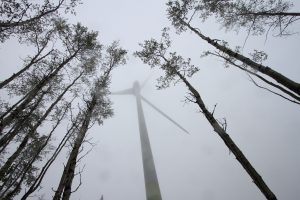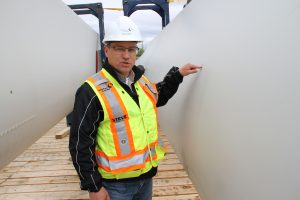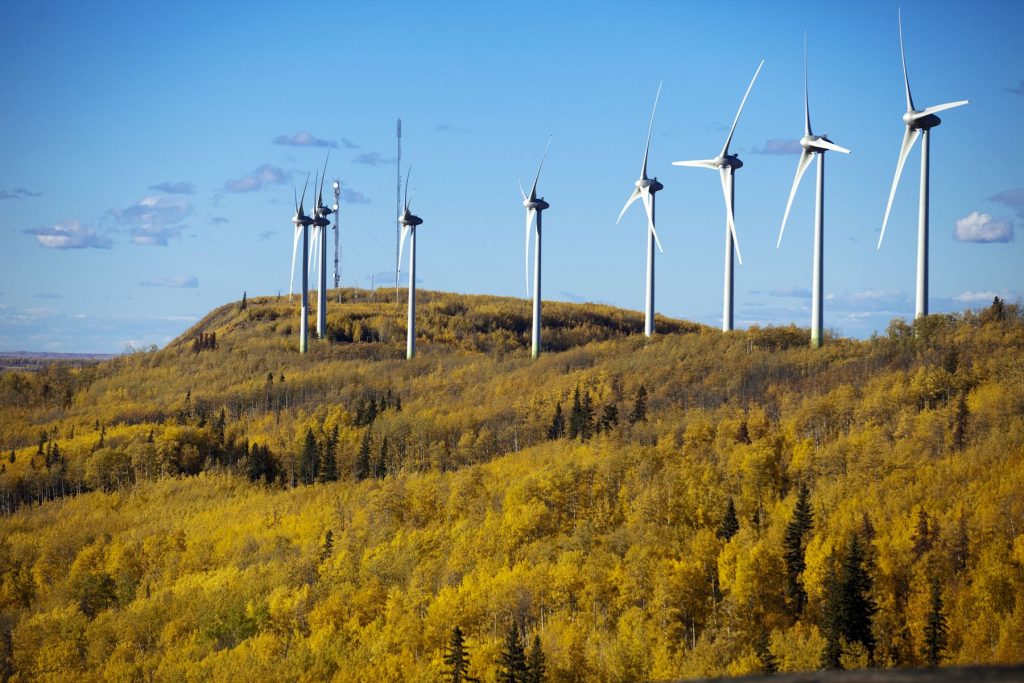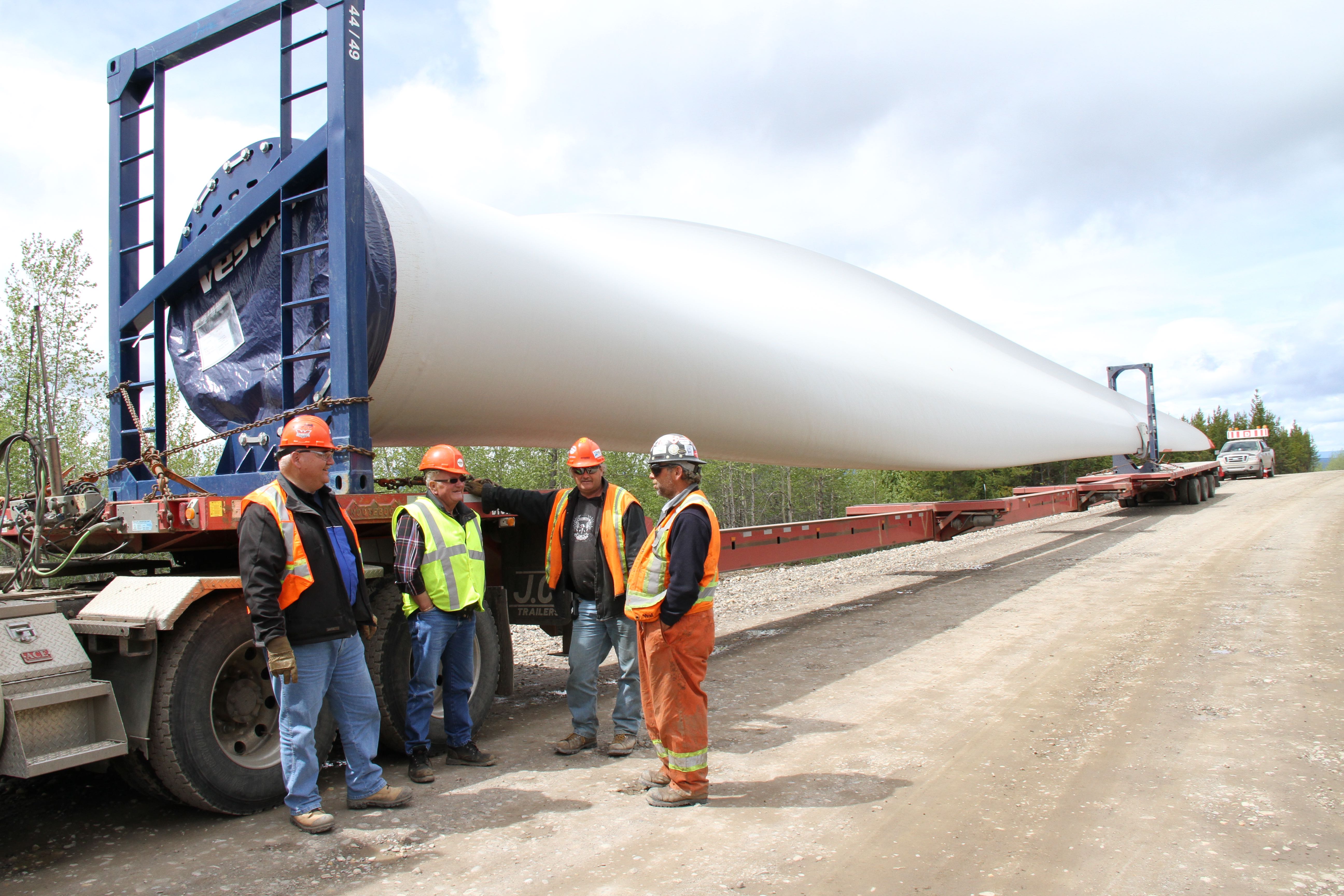By David Dodge and Duncan Kinney
While British Columbia might have a reputation as a verdant hippy haven it might surprise you to learn that B.C just got its first three wind farms in the last few years.
The story of how wind got started in BC is a tale of two dramatically different approaches to energy development – one a local, community-based energy cooperative and the other a large, corporate energy company.
British Columbia’s Peace region is the economic engine of Canada’s third most populous province. Home to the massive Montney and Horn River natural gas plays companies like Encana and Chesapeake have set up shop and invested hundreds of millions of dollars in people, infrastructure and equipment in order to get their hands on trillions of cubic feet of natural gas.
But there is another resource in the area that is just starting to be exploited. It’s a resource where the fuel costs are zero and will last until the sun decides to go supernova – the wind.
Bear Mountain Wind Park – grassroots energy

A turbine rises from the mist on a cloudy day as trees frame it at the Bear Mountain Wind Park which overlooks Dawson Creek.
The Peace Region is home to B.C.’s only three wind farms, but the story of how it all got started starts not in some corporate boardroom, but around a kitchen table in Dawson Creek. Two local businessmen, Don Pettit and Paul Kurjata could see that wind power was going to be big and they were determined to make sure that the community got in on it. So they formed the Peace Energy Cooperative in October of 2003.
One of the few for-profit cooperatives in Canada at the time they set their sights on developing the nearby Bear Mountain site for wind. It overlooks the city and is used for all sorts of outdoor pursuits like cross-country skiing, ATVing, hiking, hunting and bird watching. It also happened to be quite windy.
“Our self-made goal was always to make renewable energy profitable for our membership. That was our goal.” says Don Pettit
“Everyone knew intuitively it would be a good location for a wind and it came up for grabs and we grabbed the lease.” Pettit still sits on the board of the Peace Energy Cooperative.
They got their hands on 2000 hectares of crown land and thanks to some data from BC Hydro on an existing communications tower they got the preliminary proof they needed that it was a good wind location.
 With a good location and a proven wind resource all they needed was $200 million dollars to develop their project. “We didn’t exactly have that kind of cash lying around so we started looking for developers,” says Pettit.
With a good location and a proven wind resource all they needed was $200 million dollars to develop their project. “We didn’t exactly have that kind of cash lying around so we started looking for developers,” says Pettit.
They eventually settled on Aeolis Wind Corporation who helped them find the financing needed to build the 102 megawatt wind farm built with 34 state-of-the-art German Enercon wind turbines. It was a massive success for a small grassroots cooperative.
“I don’t think you can overplay the benefit of a cooperative model for this kind of development. What you’re doing is you’re involved the people in the area who will be affected, they will see it. You’re involving them in the planning and consultation stages and because they’re members of the co-op they’re part owners of the facility,” says Pettit.
Today the Peace Energy Cooperative has more than 400 members and the coop was an incubator of green ideas and leaders throughout the community. Former Mayor Calvin Kruk was active in the coop and current councilor Cheryl Shuman was a member as well before running for office.
By having the process led by locals you don’t get any of the local blowback you’ve seen in places like Ontario.
“We’re local people, we live here, we started this project, we moved it forward and we helped complete it. It’s a local initiative. If you can make a wind project a local initiative, and not some corporation coming in from Europe and developing in your backyard, you can see the difference quite clearly. That’s the difference we explored here. That’s the difference that worked here.”
Eventually the company that financed the project, Altagas, ended up owning the majority of Bear Mountain Wind Park. Aeolis and Peace Energy Cooperative are still minority partners and it provides steady, guaranteed income to the Peace Energy Cooperative for a 20-year term.
The process helped turn Bear Mountain Wind Park into something that has come to define Dawson Creek as one of the most sustainable cities in North America. The wind park that overlooks the city produces six times more energy than residents need on a net basis. All of this interest in green energy has also led to years of solid sustainability policy development that culminated in a $100 a tonne internal carbon tax. For more information see Awesome Dawson Creek Episode 8.
Quality Wind Project uses quality wind resources

This blade will be attached to a turbine at the Quality Wind project and is 49 meters long.

Steve Owens is a project manager for Capital Power on the Quality Wind project.
After Bear Mountain Wind Farm came online it was soon followed by the 144 MW Dokie Wind Project in Chetwynd. Now, Edmonton-based Capital Power is building B.C.’s third wind farm just south of Dawson Creek near the small coal mining community of Tumbler Ridge. The 142 megawatt installation features 79 V-90 and V-100 1.8 megawatt Vestas turbines manufactured in Colorado and shipped by rail to Rycroft, Alberta where they are then moved to the site by special trucks.
“We’re talking a lot of axles to move these around,” says Steve Owens a senior project manager for Capital Power and one of the people in charge of making sure this mammoth job ends up being done right and on time. It takes an organized person to run a site when you’re coordinating thousands of truck loads of wind components over a summer.
This wind farm will produce enough energy to power 43,000 homes and when it comes online later this year (November is the expected date) it will be the second largest wind farm in British Columbia.
As they’ve done in other projects Capital Power let a smaller developer prove the project and then moved in with the financing and the construction and engineering know-how to get the job done.
When we visited they were in the middle of erecting these massive machines and it’s special game of Lego they play with multiple cranes, massive parts and load after load of concrete.
The base, which takes 40 truckloads of concrete to set up, is surprisingly small. Owens, describes it as being akin to a wine glass, a tall tower with spread footing to support the turbine on top. From the base to the centre of the hub these Vestas turbines are either 95 or 100 metres tall and the blades swing 40 metres out for a sweep diameter of 80 metres. Seeing them on the back of a truck or tilted out at weird angles as cranes shimmy into them place really gives you a sense of perspective you don’t get from seeing a finished turbine turning calmly in a breeze.
Big wind – two ways

Bear Mountain Wind Park defines the skyline around the city of Dawson Creek.
British Columbia has witnessed two ways to develop a wind farm: one a grassroots, bottom up cooperative process and the other a top-down, profit driven, corporate process. In a province that is just starting to get its feet wet when it comes to wind energy, there is lots of room for experimentation with different models. Fortunately both deliver excellent returns and both provide carbon free electricity.
While northeastern BC doesn’t have the population density of southern Ontario bringing the community on board has massive advantags. The Bear Mountain Wind Park was developed with high levels of public support that continues to this day.
Yet you have people in some places in Ontario who travel around and disrupt presentations on wind power while a cooperatively owned 600 kilowatt wind turbine sits in Exhibition Place in downtown Toronto while people read books and laze in the sun nearby. One wonders if much of Ontario’s turmoil could have been avoided with more organized community and cooperative involvement.
As the saying goes your own pigs don’t stink. Wind energy’s acceptance in places with lots of wind power development like Denmark and Germany can be partly attributed to the dispersal of ownership across cooperatives and individuals. A quarter of the wind generation in Denmark has been developed by windmill guilds (vindmølleaug) or what we could call cooperatives. Farmers themselves own another 25 per cent of wind capacity in Denmark. Germany too has been a model in this regard. More than 100,000 households in Denmark and another 200,000 people in Germany own a share in a nearby wind turbine, writes Paul Gipe.
Whether a wind project is developed in a private or cooperative business there are clearly good and bad practices. If you are interested in cooperative projects check out the resources provided by Paul Gipe at Windworks. If you are curious about big companies that seem to be doing a good job, check out our story on Dan Balaban, the Wind Energy Cowboy.
[flickrshow:72157631442543780,width=625]
